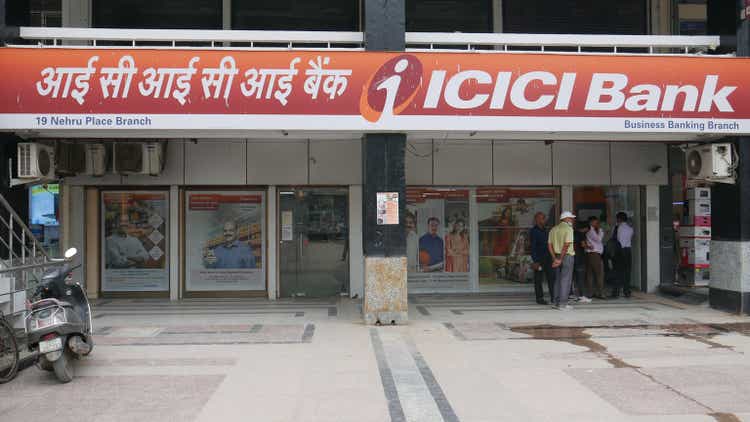
Sumit Singh Sengar/iStock Editorial via Getty Images
Elevator Pitch
I assign a Hold investment rating to ICICI Bank (NYSE:IBN) [ICICIBC:IN]. Credit ratings agency Fitch refers to ICICI Bank as India’s “second-largest private bank”, trailing only HDFC Bank Limited (HDB) [HDFCB:IN].
In this article, my focus is on ICICI Bank’s Q2 FY 2023 (YE March) financial results which were recently announced on October 22, 2022. IBN’s core operating profit expanded by +24% YoY from INR95 billion in Q2 FY 2022 to INR118 billion in the recent quarter, which beat the sell-side’s consensus forecast by approximately +7% according to S&P Capital IQ data. I analyze ICICI Bank’s key second quarter metrics in detail in the subsequent sections.
My analysis leads me to the conclusion that the risk-reward for ICICI Bank is balanced, which warrants a Hold rating for the company’s shares. On one hand, I don’t find ICICI Bank’s valuations attractive, especially in view of the bank’s weaker net interest margin outlook. On the other hand, I have been impressed with IBN’s loan growth and asset quality metrics for the recent quarter, and I also view ICICI Bank as a good play on the Indian economy.
Loan Growth
Loans for ICICI Bank increased by +5% QoQ and +23% YoY to INR9.4 trillion as of September 30, 2022. Almost all of its key segments witnessed an expansion in their respective loan portfolios in the most recent quarter.
ICICI Bank’s retail loans grew by +6% QoQ to INR5.1 trillion as of the end of second quarter of fiscal 2023. Retail is the bank’s largest segment accounting for around 54% of IBN’s total loans. Loans for the bank’s other key segments, SME, corporate, business banking, also increased by +6%, +7%, and +11%, respectively, on a QoQ basis during the same period.
In fact, ICICI Bank’s overseas segment, which only contributed 4% of the bank’s overall loan portfolio, was the only segment that saw a decline in Q2 FY 2023. In the recent quarter, loans for IBN’s overseas segment contracted by -2% YoY and -17% QoQ. IBN explained at its Q2 FY 2023 earnings briefing that the drop in loans for the overseas segment is attributable to “maturities of the short-term India-linked trade book”, rather than any fundamental issues.
India’s economy remains healthy, and this certainly played a key role in boosting the loan growth of ICICI Bank in the recent quarter. An October 6, 2022 Business Insider India article cited research from Indian “credit bureau CRIF High Mark” noting that “FY22 witnessed tremendous growth in new loan originations across retail, microfinance and commercial loans” in India which “signals economic recovery.” Notably, IBN also commented at its recent quarterly earnings call that “the recovery from the pandemic in India has been quite strong” and highlighted that “the (Indian) consumer is in good shape.”
As I mentioned at the beginning of this article, ICICI Bank is the second largest player in the Indian banking industry, which makes it a good proxy for the growth of the Indian economy.
Asset Quality
At the bank’s second quarter investor call, IBN emphasized that its approach is “growing our loan portfolio in a granular manner with a focus on risk and reward.” This is reflected in ICICI Bank’s decent asset quality metrics as highlighted below.
ICICI Bank’s Net Non Performing Assets ratio decreased from 0.99% as of end-Q2 FY 2022 to 0.61% as of end-Q2 FY 2023. The Non Performing Loans coverage ratio for IBN increased from 79.6% as of June 30, 2022 to 80.6% as of September 30, 2022.
Net Interest Margin
ICICI Bank’s net interest income went up by +12% QoQ and +27% YoY to INR148 billion in the second quarter of the current fiscal year. This was driven by a +0.31 percentage points QoQ growth and a +0.30 percentage points YoY increase in IBN’s net interest margin to 4.31% in the recent quarter.
Net interest margin for IBN grew strongly in Q2 FY 2023, because its yield on advances increased at a faster pace than its cost of deposits. ICICI Bank’s cost of deposits expanded by +9 basis points QoQ and +2 basis points YoY to 3.55% in the second quarter. In the same time frame, the yield on advances for IBN grew by +51 basis points QoQ and +29 basis points YoY to 8.63%.
At its Q2 FY 2023 results briefing, ICICI Bank attributed its net interest margin expansion to the “increase in interest rates on loan yields while repricing of deposits occurs with a lag.” However, IBN also cautioned at the recent quarterly results call that “it would be fair to assume that the repricing of deposits will pick up” going forward.
Based on the sell-side’s consensus financial projections taken from S&P Capital IQ, ICICI Bank’s net interest margin is forecasted to contract by -16 basis points from 3.96% in fiscal 2022 to 3.80% for fiscal 2023. This is consistent with IBN’s management comments with regards to a faster rate of increase in cost of deposits, which will hurt ICICI Bank’s future net interest margin.
Valuations
ICICI Bank’s current valuations are unattractive. The stock trades at a slight premium to its closest peer, HDFC Bank, even though its forward ROEs are inferior.
The market values ICICI Bank at 3.28 times trailing price-to-tangible book value and expects the bank to deliver a ROE of 15.4% for FY 2023 as per S&P Capital IQ’s consensus data. In contrast, HDFC Bank currently trades at a relatively lower trailing price-to-tangible book multiple of 3.14 times, although its consensus forward FY 2023 ROE is much higher at 18.0%.
Closing Thoughts
ICICI Bank is a Hold. I like IBN’s strong loan growth prospects and healthy asset quality. But I expect that ICICI Bank won’t be able to sustain its current pace of net interest margin expansion going forward, and its valuations aren’t unappealing based on a peer comparison. As such, I think that a Hold investment rating for ICICI Bank is justified.


Be the first to comment